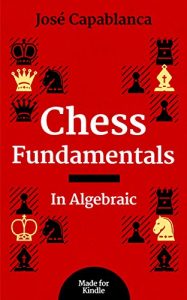Learn the fundamentals of how to become a better chess player
This edition includes diagrams and is in algebraic notation.
Chess Grandmaster Jose Capablanca aimed this title at beginners and intermediate players. It shows the fundamentals needed to become a great chess player. His style of chess was influential in the play of future world champions Bobby Fischer and Anatoly Karpov.
Execute the best chess openings
Many of Capablanca's own games are included in this handbook with practical advice on the best moves to play. Capablanca also clearly shows mistakes which can creep into a game and how to avoid them.
Learn how to master chess
Capablanca outlines tactical play showing the principals of attack, sacrifices and defence. He shows what moves to play and clearly explains the strategy behind them.
Chess endgame training
Throughout the book he gives tips on how to become a better player. As well as looking at games he triumphed in, he also looks at games that he lost and explains what could have been done differently - a key way to improve your game.
This concise book looks at many different aspects of chess from openings, middle-game through to end games and also includes notable chess games with analysis from Capablanca.
Improve your playing level and learn from Capablanca. This insightful book gives a view into the mind of a chess genius. Use it to improve your game.
Introduction to Chess Fundamentals by Jose Capablanca
In chess the tactics may change but the strategic fundamental principles are always the same, so that Chess Fundamentals is as good now as it was thirteen years ago. It will be as good a hundred years from now; as long in fact as the laws and rules of the game remain what they are at present. The reader may therefore go over the contents of the book with the assurance that there is in it everything he needs, and that there is nothing to be added and nothing to be changed. Chess Fundamentals was the one standard work of its kind thirteen years ago and the author firmly believes that it is the one standard work of its kind now.
Chess Fundamentals contents
Chapter 1 - First Principles: Endings, Middle-Game And Openings
1. Some Simple Mates
2. Pawn Promotion
3. Pawn Endings
4. Some Winning Positions in the Middle-game
5. Relative Value of the Pieces
6. General Strategy of the Opening
7. Control of the centre
8. Traps
Chapter 2 - Further Principles In End-Game Play
9. A Cardinal Principle
10. A Classical Ending
11. Obtaining a Passed Pawn
12. How to find out which Pawn will be the first to Queen
13. The Opposition
14. The Relative Value of Knight and Bishop
15. How to Mate with Knight and Bishop
16. Queen against Rook
Chapter 3 - Planning A Win In Middle-Game Play
17. Attacking without the aid of Knights
18. Attacking with Knights as a Prominent Force
19. Winning by Indirect Attack
Chapter 4 - General Theory
20. The Initiative
21. Direct Attacks en masse
22. The Force of the Threatened Attack
23. Relinquishing the Initiative
24. Cutting off Pieces from the Scene of Action
25. A Player’s Motives Criticised in a Specimen Game
Chapter 5 - End-Game Strategy
26. The Sudden Attack from a Different Side
27. The Danger of a Safe Position
28. Endings with one Rook and Pawns
29. A Difficult Ending: Two Rooks and Pawns
30. Rook, Bishop and Pawns v. Rook, Knight and Pawns (A Final Example of preserving Freedom whilst imposing restraint.)
Chapter 6 - Further Openings And Middle-Games
31. Some Salient Points about Pawns
32. Some Possible Developments from a Ruy Lopez
33. The Influence of a “Hole”
14 Competitive Games annotated and commented on.






